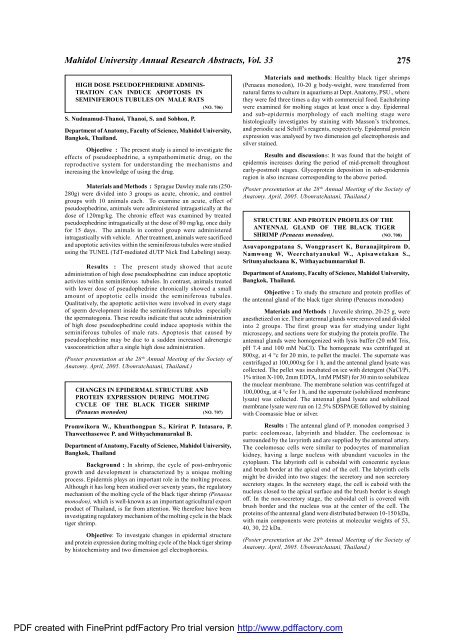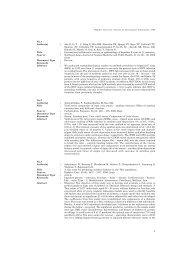Faculty of Science - Mahidol University
Faculty of Science - Mahidol University
Faculty of Science - Mahidol University
You also want an ePaper? Increase the reach of your titles
YUMPU automatically turns print PDFs into web optimized ePapers that Google loves.
<strong>Mahidol</strong> <strong>University</strong> Annual Research Abstracts, Vol. 33 275<br />
HIGH DOSE PSEUDOEPHEDRINE ADMINIS-<br />
TRATION CAN INDUCE APOPTOSIS IN<br />
SEMINIFEROUS TUBULES ON MALE RATS<br />
S. Nudmamud-Thanoi, Thanoi, S. and Sobhon, P.<br />
(NO. 706)<br />
Department <strong>of</strong> Anatomy, <strong>Faculty</strong> <strong>of</strong> <strong>Science</strong>, <strong>Mahidol</strong> <strong>University</strong>,<br />
Bangkok, Thailand.<br />
Objective : The present study is aimed to investigate the<br />
effects <strong>of</strong> pseudoephedrine, a sympathomimetic drug, on the<br />
reproductive system for understanding the mechanisms and<br />
increasing the knowledge <strong>of</strong> using the drug.<br />
Materials and Methods : Sprague Dawley male rats (250-<br />
280g) were divided into 3 groups as acute, chronic, and control<br />
groups with 10 animals each. To examine an acute, effect <strong>of</strong><br />
pseudoephedrine, amimals were administered intragastically at the<br />
dose <strong>of</strong> 120mg/kg. The chronic effect was examined by treated<br />
pseudoephedrine intragastically at the dose <strong>of</strong> 80 mg/kg, once daily<br />
for 15 days. The animals in control group were administered<br />
intragastically with vehicle. After treatment, animals were sacrificed<br />
and apoptotic activites within the seminiferous tubules were studied<br />
using the TUNEL (TdT-mediated dUTP Nick End Labeling) assay.<br />
Results : The present study showed that acute<br />
administration <strong>of</strong> high dose pseudoephedrine can induce apoptotic<br />
activites within seminiferous tubules. In contrast, animals treated<br />
with lower dose <strong>of</strong> pseudophedrine chronically showed a small<br />
amount <strong>of</strong> apoptotic cells inside the seminiferous tubules.<br />
Qualitatively, the apoptotic actiivites were involved in every stage<br />
<strong>of</strong> sperm development inside the seminiferous tubules especially<br />
the spermatogonia. These results indicate that acute administration<br />
<strong>of</strong> high dose pseudoephedrine could induce apoptosis within the<br />
seminiferous tubules <strong>of</strong> male rats. Apoptosis that caused by<br />
pseudoephedrine may be due to a sudden increased adrenergic<br />
vasoconstriction after a single high dose administration.<br />
(Poster presentation at the 28 th Annual Meeting <strong>of</strong> the Society <strong>of</strong><br />
Anatomy. April, 2005. Ubonratchatani, Thailand.)<br />
CHANGES IN EPIDERMAL STRUCTURE AND<br />
PROTEIN EXPRESSION DURING MOLTING<br />
CYCLE OF THE BLACK TIGER SHRIMP<br />
(Penaeus monodon) (NO. 707)<br />
Promwikorn W., Khunthongpan S., Kirirat P. Intasaro, P.<br />
Thaweethasewee P. and Withyachmunarnkul B.<br />
Department <strong>of</strong> Anatomy, <strong>Faculty</strong> <strong>of</strong> <strong>Science</strong>, <strong>Mahidol</strong> <strong>University</strong>,<br />
Bangkok, Thailand<br />
Background : In shrimp, the cycle <strong>of</strong> post-embryonic<br />
growth and development is characterized by a unique molting<br />
process. Epidermis plays an important role in the molting process.<br />
Although it has long been studied over seventy years, the regulatory<br />
mechanism <strong>of</strong> the molting cycle <strong>of</strong> the black tiger shrimp (Penaeus<br />
monodon), which is well-known as an important agricultural export<br />
product <strong>of</strong> Thailand, is far from attention. We therefore have been<br />
investigating regulatory mechanism <strong>of</strong> the molting cycle in the black<br />
tiger shrimp.<br />
Objective: To investgate changes in epidermal structure<br />
and protein expression during molting cycle <strong>of</strong> the black tiger shrimp<br />
by histochemistry and two dimension gel electrophoresis.<br />
Materials and methods: Healthy black tiger shrimps<br />
(Penaeus monodon), 10-20 g body-weight, were transferred from<br />
natural farms to culture in aquariums at Dept. Anatomy, PSU., where<br />
they were fed three times a day with commercial food. Eachshrimp<br />
were examined for molting stages at least once a day. Epidermal<br />
and sub-epidermis morphology <strong>of</strong> each molting stage were<br />
histologically investigates by staining with Masson’s trichromes,<br />
and periodic acid Schiff’s reagents, respectively. Epidermal protein<br />
expression was analysed by two dimension gel electrophoresis and<br />
silver stained.<br />
Results and discussions: It was found that the height <strong>of</strong><br />
epidermis increases during the period <strong>of</strong> mid-premolt throughout<br />
early-postmolt stages. Glycoprotein deposition in sub-epidermis<br />
region is also increase corresponding to the above period.<br />
(Poster presentation at the 28 th Annual Meeting <strong>of</strong> the Society <strong>of</strong><br />
Anatomy. April, 2005. Ubonratchatani, Thailand.)<br />
STRUCTURE AND PROTEIN PROFILES OF THE<br />
ANTENNAL GLAND OF THE BLACK TIGER<br />
SHRIMP (Penaeus monodon). (NO. 708)<br />
Asuvapongpatana S, Wongprasert K, Buranajitpirom D,<br />
Namwong W, Weerchatyanukul W., Apisawetakan S.,<br />
Sritunyalucksana K, Withayachumnarnkul B.<br />
Department <strong>of</strong> Anatomy, <strong>Faculty</strong> <strong>of</strong> <strong>Science</strong>, <strong>Mahidol</strong> <strong>University</strong>,<br />
Bangkok, Thailand.<br />
Objective : To study the structure and protein pr<strong>of</strong>iles <strong>of</strong><br />
the antennal gland <strong>of</strong> the black tiger shrimp (Penaeus monodon)<br />
Materials and Methods : Juvenile shrimp, 20-25 g, were<br />
anesthetized on ice. Their anternnal glands were removed and divided<br />
into 2 groups. The first group was for studying under light<br />
microscopy, and sections were for studying the protein pr<strong>of</strong>ile. The<br />
antennal glands were homogenized with lysis buffer (20 mM Tris,<br />
pH 7.4 and 100 mM NaCl). The homogenate was centrifuged at<br />
800xg, at 4 °c for 20 min, to pellet the muclei. The supernate was<br />
centrifuged at 100,000xg for 1 h, and the antennal gland lysate was<br />
collected. The pellet was incubated on ice with detergent (NaCl/Pi,<br />
1% triton X-100, 2mm EDTA, 1mM PMSF) for 30 min to solubileze<br />
the muclear membrane. The membrane solution was centrifuged at<br />
100,000xg, at 4 °c for 1 h, and the supernate (solubilized membrane<br />
lysate) was collected. The antennal gland lysate and solubilized<br />
membrane lysate were run on 12.5% SDSPAGE followed by staining<br />
with Coomassie blue or silver.<br />
Results : The antennal gland <strong>of</strong> P. monodon comprised 3<br />
parts: coelomosac, labyrinth and bladder. The coelomosac is<br />
surrounded by the lavyrinth and are supplied by the antennal artery.<br />
The coelomosac cells were similar to podocytes <strong>of</strong> mammalian<br />
kidney, having a large nucleus with abundant vacuoles in the<br />
cytoplasm. The labyrinth cell is cuboidal with concentric nycleus<br />
and brush border at the apical end <strong>of</strong> the cell. The labyrinth cells<br />
might be divided into two stages: the secretory and non secretory<br />
secretory stages. In the secretory stage, the cell is cuboid with the<br />
nucleus closed to the apical surface and the brush border is slough<br />
<strong>of</strong>f. In the non-secretory stage, the cuboidal cell is covered with<br />
brush border and the nucleus was at the center <strong>of</strong> the cell. The<br />
proteins <strong>of</strong> the antennal gland were distributed between 10-150 kDa,<br />
with main components were proteins at molecular weights <strong>of</strong> 53,<br />
40, 30, 22 kDa.<br />
(Poster presentation at the 28 th Annual Meeting <strong>of</strong> the Society <strong>of</strong><br />
Anatomy. April, 2005. Ubonratchatani, Thailand.)<br />
PDF created with FinePrint pdfFactory Pro trial version http://www.pdffactory.com
















